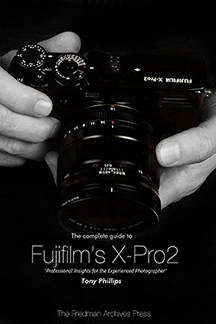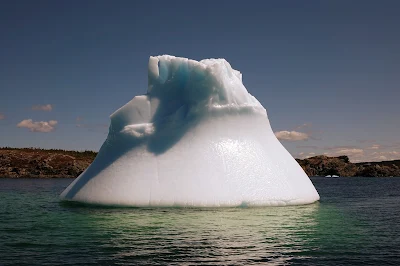In this issue:
What Does a Photographer Bring on Vacation?
What RAW Corruption Looks Like
Unobvious Things about the Sony Alpha 6300 (video)
Fujifilm X-Pro2 ebook out!
Updates on other books
What does a Photographer Bring on Vacation?
Because of all the books I write, I probably have more cameras than should be allowed by law, which makes it especially challenging to decide what to take when going on vacation. (I know; none of you feel sorry for me. I'm OK with that.) In the past I'd take the best equipment I had just because "Hey, how can I NOT do that when I'm going to exotic places like Australia and New Zealand?". Then I end up schlepping a backpack full of E-mount lenses and bodies which, despite the bodies' smaller size, still ended up weighing a ton.
So when going on a personal vacation (as opposed to a working one), I don't want to be burdened by my equipment like that. I just want to bring something small that can do pretty much everything pretty well but won't weigh me down. The Sony Alpha 6300 (whose ebook is out, and a video for which appears later in this post) would be an obvious choice here, but because of where I would be I really didn't want to mess with changing lenses either.
So what did I bring? One of the most underloved cameras Sony has ever produced:
The RX-10 II.
If you've been reading this blog for any length of time, you'll know just how much I love the RX-100 series of point-and-shoots. The RX-10 II essentially takes that very same sensor and compute engine and slaps a superb Zeiss 24-200 f/2.8 lens in front of it.
 |
| That lens! Go ahead, download the full-res file, view at 100%, and count the eyelashes. |
 |
| Also this image from earlier in the year. |
 |
| If your light is good, the image quality is outstanding. |
 |
| Family photo from that trip - nobody can tell that a small-sensor camera was responsible. |
The truth is that for most non-commercial purposes, the most any normal person needs for their photography is about 16 megapixels (even when viewing on a Retina display), which makes this 20-megapixel camera ideal for carefree travel. One further benefit is that although it has the light-gathering ability of an f/2.8 lens, it has the depth-of-field of a full-frame lens set to f/8 (see choral examples below).
 |
| A wide shot of a low-light choral performance... |
 |
| ...and a close-up a few seconds later. |
 |
| A Bar Mitzvah in Pennsylvania. Bokeh lovers won't be impressed with the way the out-of-focus portions are rendered; however I wasn't planning on taking pro-level head shots on this trip. |
 |
| Perfectly licensable image... not everyone needs shallow depth-of-field all of the time. |
 |
| A boat house that, remarkably, is still standing. |
I have other nice shots too, but I don't want to bore you. Instead, let me share with you a mistake I made on this trip which I will never, ever repeat again.
What RAW Corruption Looks Like
When you're on vacation you get lax about everything. Normally when I travel I bring two 1-terabyte hard drives, and every night I empty my memory cards to both drives (and store them in different places - one comes with me, one stays at the hotel) just in case something bad happens. On this trip I decided to lighten up and take only ONE external hard drive, keeping just the .jpgs on my laptop because my SSD storage couldn't hold all the RAW files.
So of course the hard drive experienced some sort of formatting error, and I estimate that about 1% of the RAW files became corrupted. The worst example appears below; I'll show a typical example in a minute.
 |
| Worst RAW file corruption I've seen. |
Normally I never touch my RAW files because if my light is good and my exposure is right for that light, the benefits of RAW are not that compelling. Here, though, my light was awful and so I had to do some rather extreme post-processing in order to make the images draw your eye. And it's this extreme manipulation that the .jpgs just don't handle as well as RAW does. Below is the out-of-camera .jpg and then a processed .jpg to make it look more engaging. But look carefully at the sky and you'll see what can only be described as "splotchiness".
 |
| Original .jpg, straight out of camera. |
 |
| .jpg processed for drama. Look at the splotchiness in the sky! .jpgs just can't take extreme manipulation like RAW files can. |
Fortunately I was able to make those go away using the healing brush tool in Photoshop. And as you can see the splotchiness in the sky never appeared in this version.
But what I really learned in this process is that there are NO image repair tools available for Sony .ARW files (like there are for .jpgs). Lesson re-learned: Redundancy is your only hope against certain technological failure.
Announcements
 Fujifilm X-Pro2 Ebook by Tony Phillips is out! Please help spread the news online.
Fujifilm X-Pro2 Ebook by Tony Phillips is out! Please help spread the news online.A6300 ebook updated: Version 1.03 of the A6300 is now available, as are the .epub and .mobi versions. Email me with your purchase receipt if you didn't receive automatic notification and I'll send you a download link.
Version 1.2 of the Sony A7R II ebook has been updated as well. If you purchased it from my website, you will have been automatically notified. If elsewhere, email me your purchase receipt and I'll send you the latest download link!
Next Time in f2 Cameracraft
These impressive dance images were born of frustration. The couple's 13-year-old daughter with dancing aspirations wanted to fill her room with dance photos, but there were no photos of current dancers which she admired. So her parents set up a small studio in their Brooklyn apartment and invited over today's dance greats.
Learn the secrets behind these and many other iconic shots; subscribe to f2 Cameracraft!
Unobvious Things about the A6300
And now, a word from our sponsor:
Seminars
I'm currently working with some camera clubs in Colorado, Arizona, and Nova Scotia to bring the Friedman Archives High-Impact Photography seminars out to them. We can energize your photo club as well! Email me for more details.
Yours Truly, Gary Friedman











An RX-10 together with an RX-100 make an awesome combination for travel photography as long as the shooting conditions are good. I normally leave the big DSLR & lenses at home, taking them along only if I expect the shooting conditions to be very challenging.
ReplyDeleteYeah, that's pretty much what I did... except for me, the RX-100 is pretty much with me all the time, no matter where I go.
DeleteHi Gary
ReplyDeleteA couple of years ago you wrote in your blog about Flash overexposure 2013/12.
You mentioned that sony cameras was overexposure by 1 stop using TTL on cam flash.
I´m using a external flash mounted on a a77m2 and it seems that I´m having the same problem. Is this just how things work?
There isent much information anywhere about using TTL and ADI with a mounted speedlight. I tested my new Nissin d700i using GN and they are just perfect. I have a son 15 month old, so I need the flash on camera to be able to get some nice shots, he is all over when we are out in a nature park, so TTL or ADI is what I´m trying to use.
Any thought?
Christian
Hi, Christian. As I mention in the A77 II ebook, yes, this camera will tend to overexpose flash by one stop when shooting a grey card. Sometimes this looks fine when used as fill-flash (as opposed to being the sole source of light in a dark room); sometimes it looks too bright and you have to set the Flash Compensation to -1 to have it look right. Fortunately you have digital, so you can look at the results and make the adjustment if you think it's too bright for your specific shooting scenario. GF
DeleteHi Gary,
ReplyDeleteEnjoyed reading your story about the RX10.
I kept my A55 when I got an A77II. It is small and light and combined with a Tamron 18-270 PZD, a very nice vacation cam.
Sometimes I get nostalgic and take my Konica-Minolta A2 with me.
I agree that the RX-100 + RX-10 makes a perfect travel combo. But for my taste the RX-10 is not wide enough. The Olympus E-M1 + Olympus 7-14mm f2.8 + Olympus 12-40mm f2.8 + Panasonic 100-400mm f4.0 (the last one optional in case you really want to go far) make up a very nice travel combo in my opinion.
ReplyDelete